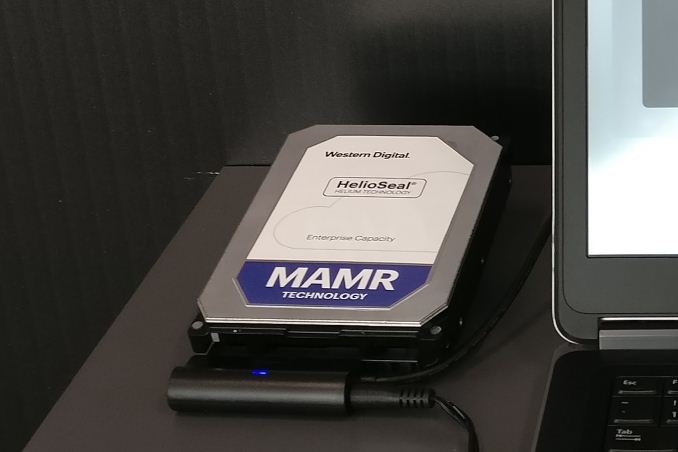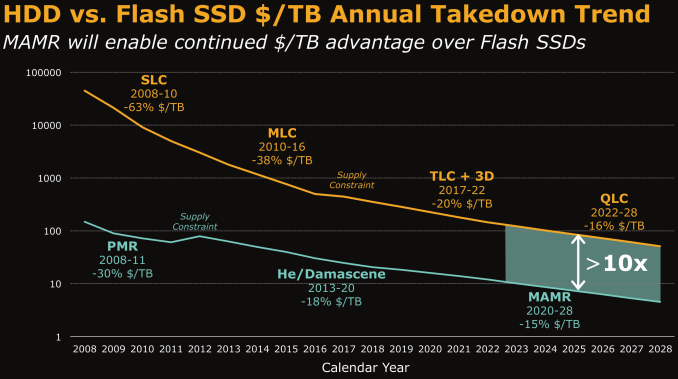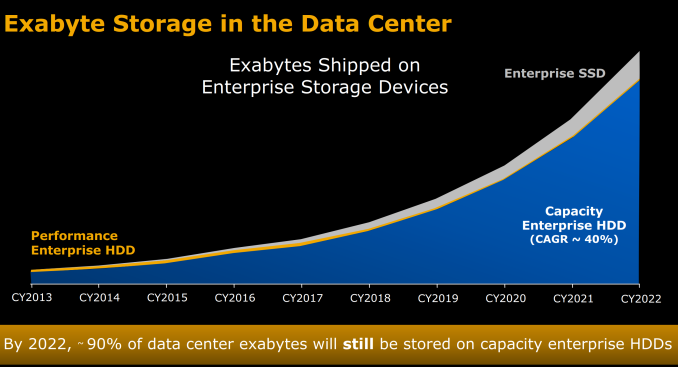Western Digital Stuns Storage Industry with MAMR Breakthrough for Next-Gen HDDs
by Ganesh T S on October 12, 2017 8:00 AM EST
Yesterday, Western Digital announced a breakthrough in microwave-assisted magnetic recording (MAMR) that completely took the storage industry by surprise. The takeaway was that Western Digital would be using MAMR instead of HAMR for driving up hard drive capacities over the next decade. Before going into the specifics, it is beneficial to have some background on the motivation behind MAMR.
Hard drives may be on the way out for client computing systems, but, they will continue to be the storage media of choice for datacenters. The Storage Networking Industry Association has the best resources for identifying trends in the hard drive industry. As recently as last year, heat-assisted magnetic recording (HAMR) was expected to be the technology update responsible for increasing hard drive capacities.

Slide Courtesy: Dr.Ed Grochowski's SNIA 2016 Storage Developer Conference Presentation
'The Magnetic Hard Disk Drive: Today’s Technical Status and Its Future' (Video, PDF)
Mechanical Hard Drives are Here to Stay
One of the common misconceptions amongst readers focused on consumer technology relates to flash / SSDs rendering HDDs obsolete. While using SSDs over HDDs is definitely true in the client computing ecosystem, it is different for bulk storage. Bulk storage in the data center, as well as the consumer market, will continue to rely on mechanical hard drives for the foreseeable future.
The main reason lies in the 'Cost per GB' metric.
Home consumers are currently looking at drives to hold 10 TB+ of data, while datacenters are looking to optimize their 'Total Cost of Ownership' (TCO) by cramming as many petabytes as possible in a single rack. This is particularly prevalant for cold storage and archival purposes, but can also expand to content delivery networks. Western Digital had a couple of slides in their launch presentation yesterday that point towards hard drives continuing to enjoy this advantage, thanks to MAMR being cost-effective.
Despite new HDD technology, advancements in solid state memory technology are running at a faster pace. As a result SSD technology and NAND Flash have ensured that performance enterprise HDDs will make up only a very minor part of the total storage capacity each year in the enterprise segment.
The projections presented by any vendor's internal research team always need to be taken with a grain of salt, but given that SanDisk is now a part of Western Digital the above market share numbers for different storage types seem entirely plausible.
In the next section, we take a look at advancements in hard drive technology over the last couple of decades. This will provide further technical context to the MAMR announcement from Western Digital.












127 Comments
View All Comments
Glaurung - Thursday, October 12, 2017 - link
Mac OS has calculated storage capacity using TB rather than TiB for years now.lmcd - Thursday, October 12, 2017 - link
That'll happen when general users refer to Gibibytes instead of Gigabytes, etc.melgross - Thursday, October 12, 2017 - link
For crying out loud. I wish we could get over this nonsense. You do realize that it's the same amount of storage? It doesn't matter which number is used, as long as everyone uses the same way of describing it.mapesdhs - Thursday, October 12, 2017 - link
It matters because computing by its very nature lends itself to the binary world, powers of 2, hex, etc., and the idea of not doing this for describing disk capacities only started as a way of making customers think they were getting more storage than they actually were. When I was at uni in the late 1980s, nobody in any context used MB, GB, etc. based on a power of ten, as everything was derived from the notion of bytes and KB, which are powers of 2. Like so many things these days, this sort of change is just yet more dumbing down, oh we must make it easier for people! Rubbish, how about for once we insist that people actual improve their intellects and learn something properly.Anyway, great article Ganesh, thanks for that! I am curious though how backup technologies are going to keep up with all this, eg. what is the future of LTO? Indeed, as consumer materials become ever more digital, surely at some point the consumer market will need viable backup solutions that are not ferociously expensive. It would be a shame if in decades' time, the future elderly have little to remember their youth because all the old digital storage devices have worn out. There's something to be said for a proper photo album...
BrokenCrayons - Thursday, October 12, 2017 - link
I have a few decrepit 5.25 inch full height hard drives (the sorts that included a bad sector map printed on their label made by companies long dead to this world) sitting in a box in my house that were from the 80s. They used a power of ten to represent capacity even before you attended university. This capacity discussion is absolutely not a new concern. It was the subject of lots of BBS drama carried out over 2400 baud modems.bcronce - Thursday, October 12, 2017 - link
For the longest time where was no common definition of a "byte". 5 bit byte? 6 bit byte? 7 bit byte? 11 bit byte? Most storage devices were labeled in bits, which is labeled in base 10.melgross - Thursday, October 12, 2017 - link
Sheesh, none of that has any importance whatsoever outside of the small geeky areas in this business.alpha754293 - Thursday, October 12, 2017 - link
...except for the companies that got sued for fraudulent advertising, because 'Murica!Ratman6161 - Thursday, October 12, 2017 - link
"It doesn't matter which number is used, as long as everyone uses the same way of describing it."You would be amazed at how many times I still get the question : "Did I get ripped off? Windows says my hard drive is smaller than what <insert PC OEM here> said in their specs!"
melgross - Thursday, October 12, 2017 - link
That's why changing the way we describe this every few years is a problem. We need a standard to be used everywhere, no matter which one. Quite frankly, almost no one will ever do what your friends, according to you, do. Most don't even know offhand, who makes their computer, much less how much storage it comes with.